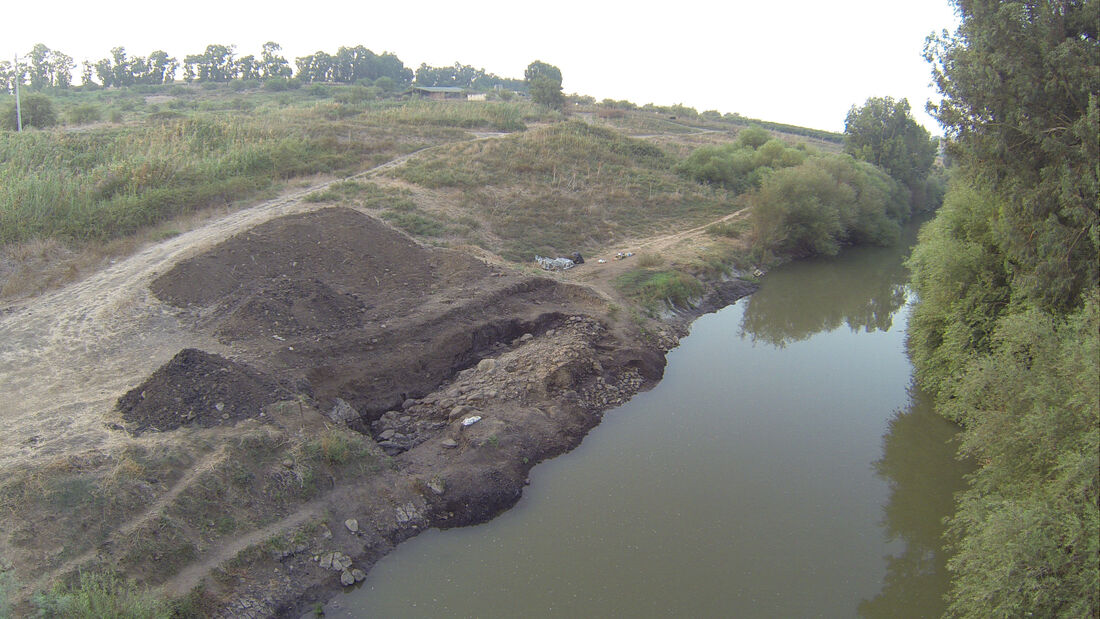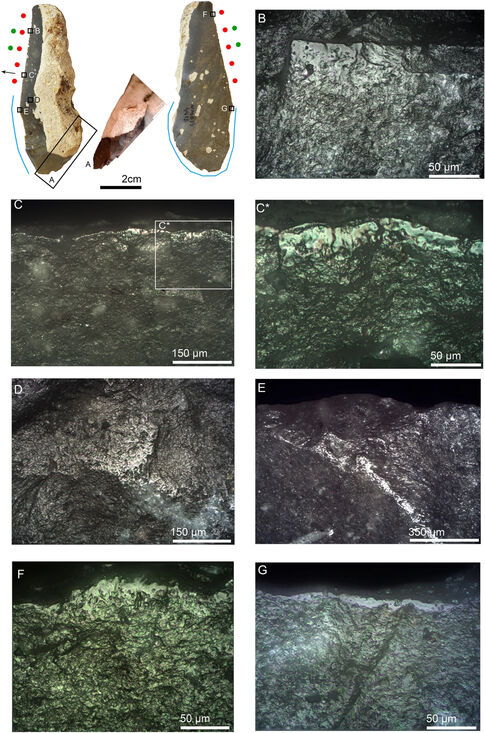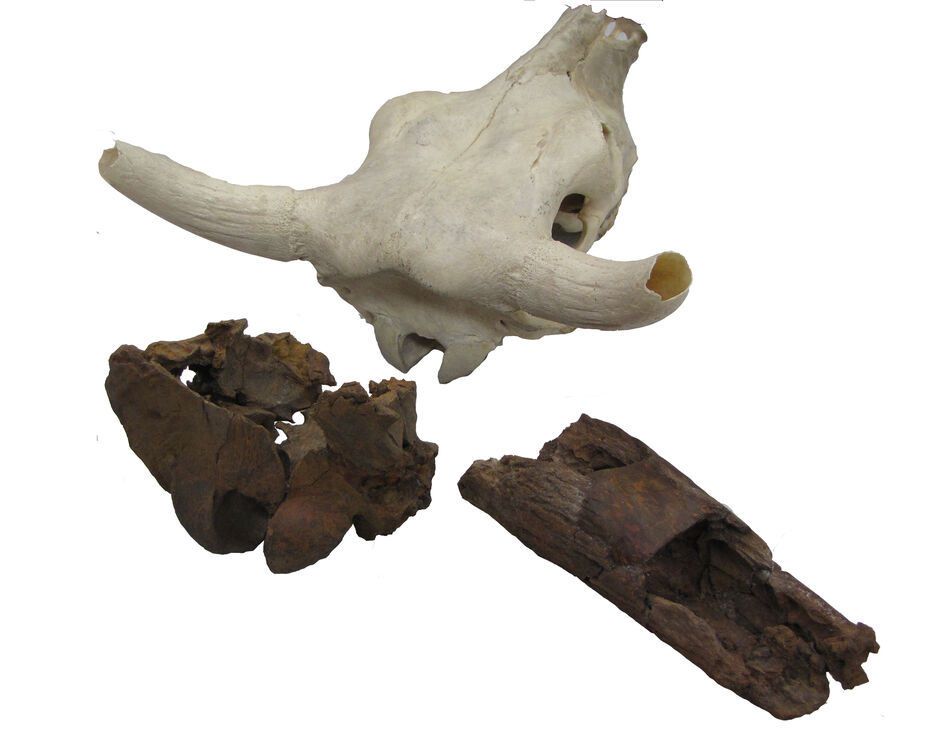New studies of unique stone tools excavated from Nahal Mahanayeem Outlet (NMO) on the Jordan River bank reveal the innovation and dexterity of Paleo-Hula Valley hunters of giant cows 60,000 years ago
Researchers from IPHES-CERCA, from Tel-Hai College and from the Hebrew University of Jerusalem have been able to reconstruct the sites of the stone remains recovered in this jaciment and the results have just been published in the Science Reports
The site of NMO is an open-air Middle Paleolithic hunting locality on the east bank of the Upper Jordan River at its outflow south from the Hula Valley. Dated to about 60,000 years before present, the site documents a short stay, perhaps up to a week in time, of hunters on the bank of the (pre-Jordan River) Paleo-Hula Lake. There, they mainly processed and butchered animals they hunted nearby. They left behind them stone tools and animal bones that were covered immediately by the lake sediments, preserving them in exceptional condition until their discovery. Thus, the NMO archaeological horizons document "a moment in the life” of the prehistoric hunters. Such sites are rare in the early prehistory of the Levant. New studies of impact and use-wear marks on the NMO stone tools demonstrate a variety of their uses: butchering, plant processing, and hafting onto wooden shafts. Moreover, the hunters apparently employed a close-range hunting technique, ambushing the giant cows whose bones are prominent among site finds. The study analysis, enabled by high magnitude microscopy, reveals innovation on the part of early prehistoric hunters equally impressive as that of the modern technological advances used to discover them.
The site of NMO, discovered as a result of Jordan River drainage operations, was excavated by a team from Tel-Hai College and the Hebrew University under the direction of Prof. Gonen Sharon. Excavation on the Jordan River bank exposed the bones of animals ranging in size from rhinoceros to birds, fish, and crabs. The Middle Paleolithic hunters at NMO hunted and processed deer, gazelle, wild boar, and both tortoises and turtles. But their primary prey were giant, wild cattle. The complete, processed bones excavated at the site point to an animal weighing up to a ton – in comparison, today’s “local” cow weighs approximately 300 kg. The NMO hunters left behind the flint tools they used for processing the giant cow carcasses and these were exposed during excavation. Two new studies examined these stone tools to explore their use, and uncovered the innovative techniques and advanced abilities employed by the site’s inhabitants.
The results of these traceological works have been published in the journal Scientific Reports, from the Nature group, in a work led by Juan Ignacio Martin-Viveros, predoctoral researcher at IPHES-CERCA and in which other researchers have participated from the same center and researchers from Tel-Hai College and the Hebrew University of Jerusalem. This work is part of his doctoral thesis entitled "Traceological analysis of mobile toolkits in high-resolution Middle Paleolithic contexts: Abric Romaní (Barcelona, Spain) and Nahal Mahanayeem Outlet (NMO, Israel)", co-directed by the IPHES-CERCA researchers Andreu Ollé and M. Gema Chacón, as well as Gonen Sharon himself.
Juan Ignacio Martin-Viveros examined use-wear marks left on the tools to discover the different tasks undertaken by the NMO inhabitants. When stone tools are used for meat processing, the edges of the tools wear out differently than when used for hard bone or for the softer vegetal material processing. These different use-wear marks were possible to detect and differentiate with high-magnitude microscopes and through comparison with a large experimental reference collection, which involved the reproduction of more than 100 experimental activities using flint collected around the Hula Valley. Indeed, the NMO flint tools preserved good, interpretable marks on their edges. Importantly, consistent with the first study, the marks indicate use of the tools primarily for butchering rather than for hunting. Interestingly, while most of the marks observed are typical of meat processing, a limited number of the tools were used for processing dry hide, bone/antler, and plant material. Dry hide processing tools indicate that skins of hunted animals could have been initially processed at NMO before leaving the site. Plants were also important to the NMO inhabitants, who used them for making handles and constructing and repairing wrappers and containers for meat transport.
An additional important find is clear evidence for the use of hafted tools. Examination revealed that the marks on the tool edges clearly change from meat processing marks on the upper section to hafting marks on the lower section. The lower section was clearly worn by a wooden handle into which the point or knife was inserted. The construction and use of hafted tools at NMO are an early example of the varied hafting expertise that NMO inhabitants possessed during the Late Middle Paleolithic of the Levant, and demonstrates the knowledge, dexterity, and innovative technology applied by the site’s inhabitants.
A surprising observation came from the study of a few “perfect” points excavated at NMO, beautiful points that appear to be in a perfectly usable state. Their production demonstrates maximal dexterity and a high sense of the aesthetic. Examination of their edges revealed no use-wear marks – these NMO “perfect” points were likely never used. The giant cattle hunters brought perfectly shaped tools to the site and left them behind. It is hard to find a functional explanation for such behavior of the ancient hunters of NMO. The answer may lay in the direction of symbolism or ceremonial behavior. Such behaviors are difficult to detect and even more rarely acknowledged in early prehistoric sites.
Article:
Martin-Viveros, J.I., Oron, M., Ollé, A., Chacón, M. Gema, Sharon, G. Butchering knives and hafting at the Late Middle Paleolithic open-air site of Nahal Mahanayeem Outlet (NMO), Israel. Scientific Reports 13, 112 (2023). https://doi.org/10.1038/s41598-022-27321-5






